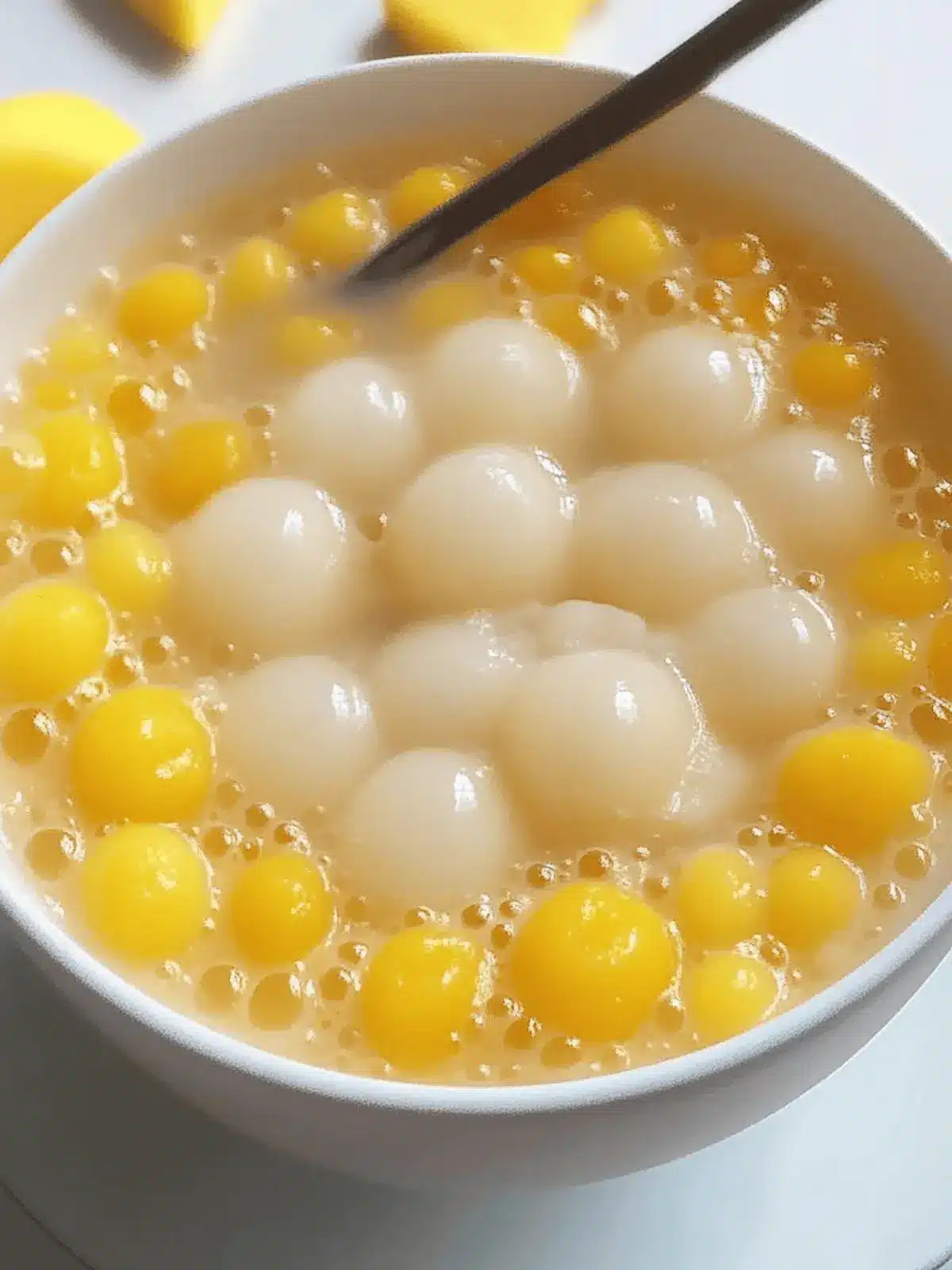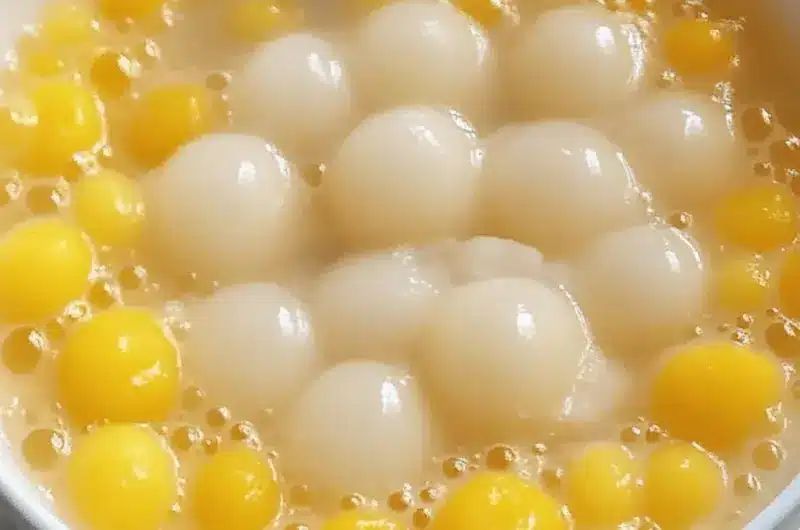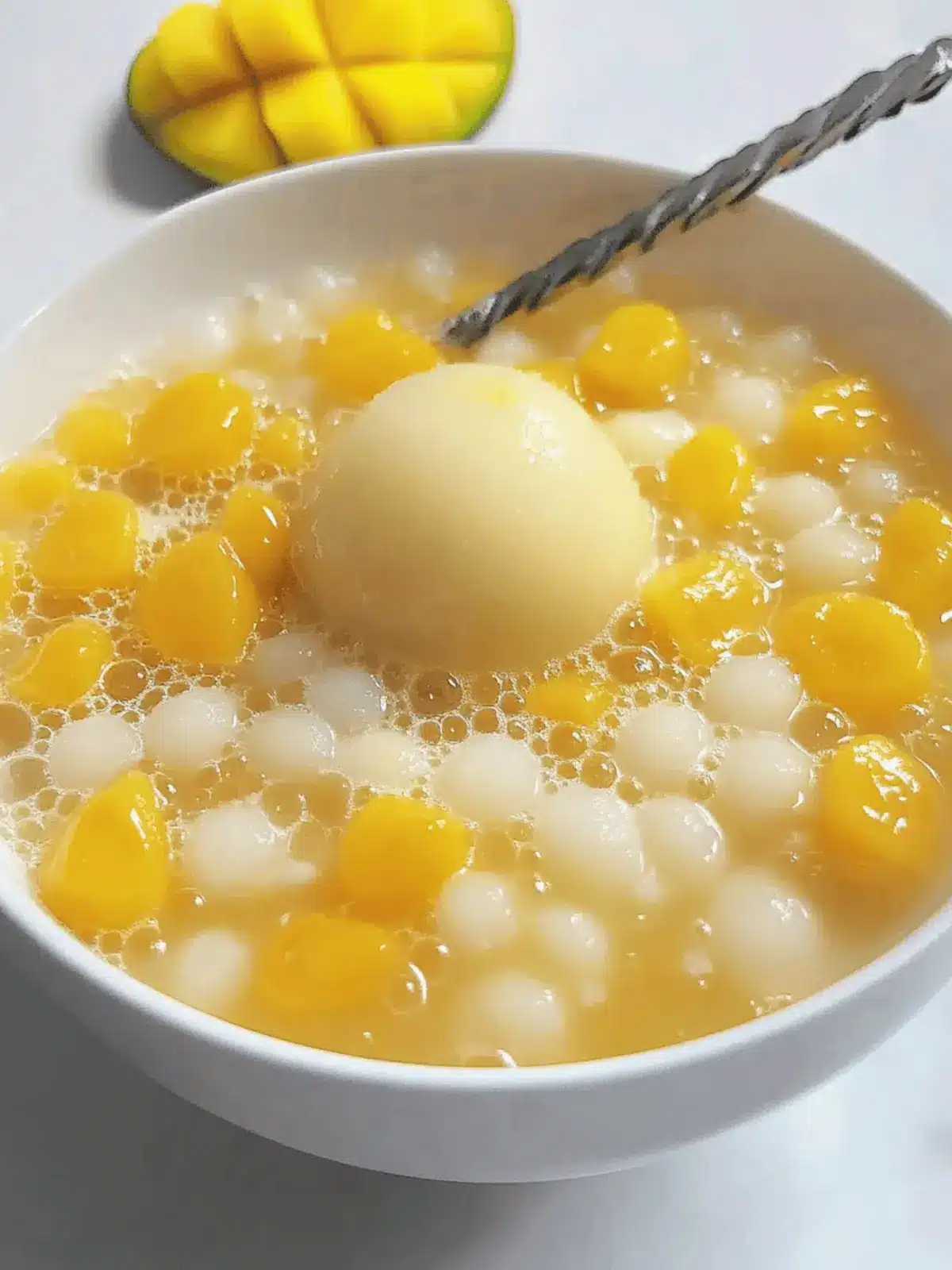As the sun beats down and the vibrant colors of summer burst into life, there’s nothing quite like a cool, refreshing treat to lift your spirits. I recently stumbled upon a flavor combination that perfectly captures the essence of sunny days: a luscious Mango Sago with Tang Yuan. Imagine the delightful contrast of a smooth, mango-infused smoothie paired with chewy sticky rice balls, all drizzled in creamy coconut milk.
This dessert not only tastes heavenly but also offers a customizable experience that lets you play with flavors and textures to please every palate. Whether you’re hosting a backyard barbecue or simply satisfying your sweet tooth, this delightful treat will fast become a favorite. Plus, it’s effortlessly simple to prepare, making it the perfect antidote to fast food fatigue. Join me on this culinary adventure and discover how to whip up this delightful summer dessert!
Why is Mango Sago with Tang Yuan a must-try?
Deliciously Unique: This recipe offers a refreshing twist on traditional desserts, blending tropical mango flavors with chewy glutinous rice balls.
Customizable: Feel free to experiment with different fruits or flavored coconut milks to create a treat that suits your taste!
Simple to Make: With just a few easy steps, you can whip up this delightful dessert—perfect for any home chef.
Summer Perfection: Enjoy it chilled, making it the ideal cool-down treat for hot, sunny days.
Crowd-Pleasing: Impress your friends and family at gatherings with this stunning dessert that is as beautiful as it is tasty!
Health-Conscious Choice: Made with fresh ingredients, this dessert is a guilt-free indulgence that’s gluten-free when using the right rice balls.
Mango Sago with Tang Yuan Ingredients
For the Sago:
- Sago – Adds a delightful chewy texture; tapioca can be used if sago is unavailable.
For the Smoothie:
- Mango Flesh – Provides natural sweetness and the star flavor; always opt for ripe mango for the best taste.
- Coconut Milk – Contributes a rich, creamy flavor; substitute with almond milk for a lighter option.
For the Glutinous Rice Balls:
- Glutinous Rice Balls – Essential for that chewy bite; use store-bought for convenience or make your own for a personal touch.
Remember, this Mango Sago with Tang Yuan can be customized with various fruits or flavored coconut milks to suit your personal taste!
How to Make Mango Sago with Tang Yuan
-
Cook the Sago:
Boil a 10:1 ratio of water to sago in a pot. Add the sago pearls and stir occasionally to prevent sticking. Cover and simmer for about 20 minutes until tiny white dots appear in the pearls. Allow it to sit covered for another 20 minutes, then rinse under cold water until they’re transparent. -
Boil the Tang Yuan:
In a separate pot, bring water to a rolling boil. Gently add the glutinous rice balls and cook until they float to the surface. Let them simmer for an additional minute before using a slotted spoon to remove them and place them in a bowl of water. -
Prepare the Mango:
Dice one ripe mango and mash half of it for a smoother puree. For a more refined texture, blend the mango with coconut milk until combined and creamy. -
Assemble:
In a serving bowl, combine the cooked sago, diced mango, and the tang yuan. Pour in the coconut milk and stir in the mango puree. Optional: Chill in the fridge for a couple of hours to boost the refreshing flavor before serving.
Optional: Garnish with fresh mint leaves for an extra touch of freshness.
Exact quantities are listed in the recipe card below.
What to Serve with Mango Sago with Tang Yuan?
Indulge in a culinary experience that beautifully complements the vibrant flavors of your refreshing dessert.
-
Fresh Fruit Salad: Bright, juicy fruits add a burst of color and flavor, enhancing the tropical vibe of the smoothie. A sprinkle of lime juice can elevate the freshness even more.
-
Coconut Sticky Rice: The same coconut richness ties it all together while the sticky rice’s texture mirrors the chewy tang yuan, creating a satisfying harmony.
-
Green Tea: This subtle and refreshing beverage can cleanse the palate, contrasting beautifully with the sweetness of the mango while offering a calming component.
-
Sweet Red Bean Soup: The earthy sweetness from this traditional dish can provide a nice balance and a comforting texture that pairs wonderfully with the smooth dessert.
-
Sesame Balls: Crispy on the outside and chewy on the inside, these delightful treats will add another layer of texture that plays well with the mango smoothie.
-
Chocolate-Covered Almonds: These add a crunchy, chocolatey element that’s both satisfying and indulgent, perfect for a sweet bite alongside your treat.
-
Mango Sorbet: A cool, fruity counterpart that amplifies the mango flavor, creating a tantalizing duo that sings of summer with every spoonful.
-
Chilled Lemonade: The zest of lemonade will brighten your taste buds, complementing the creamy sweetness of the mango while keeping the vibes refreshing.
-
Coconut Macaroons: For a sweet endnote, these chewy delights echo the coconut milk in your dessert, making for a lovely theme throughout your meal.
How to Store and Freeze Mango Sago with Tang Yuan
- Fridge: Store any leftover Mango Sago in an airtight container in the fridge for up to 2 days. This dessert tastes best when fresh, but you can still enjoy it chilled.
- Freezer: For longer storage, freeze the smoothie without the glutinous rice balls for up to 1 month. When ready to eat, thaw overnight in the fridge and add freshly boiled tang yuan.
- Reheating: If you have leftover rice balls, serve them at room temperature or gently reheat in hot water before adding them back to the smoothie for the best texture.
- Avoid Texture Changes: Freezing may alter the creamy consistency of the coconut milk, so consider adding it fresh when you’re serving your Mango Sago with Tang Yuan.
Make Ahead Options
These Mango Sago with Tang Yuan are ideal for busy home cooks looking to save time! You can prepare the sago and tang yuan up to 24 hours in advance; just store them separately in the refrigerator to maintain their chewy texture and prevent them from becoming soggy. The mango can be diced or pureed and kept in an airtight container in the fridge for up to 3 days. When you’re ready to serve, simply combine the prepped sago, tang yuan, and mango in a serving bowl, drizzle with coconut milk, and stir well. This way, you’ll have a refreshing dessert ready to impress your guests with minimal last-minute effort!
Mango Sago with Tang Yuan Variations
Feel free to elevate your Mango Sago with Tang Yuan experience by trying these fun variations!
-
Tropical Twist: Swap mango for pineapple or passion fruit for a zesty flavor. The tangy contrast will add a refreshing surprise in each bite.
-
Nutty Indulgence: Use peanut-flavored Tang Yuan for a delicious, nutty flavor. This subtle twist can take your dessert to new heights.
-
Pumpkin Power: Incorporate pumpkin puree into the smoothie for a fall-inspired treat. The natural sweetness and creaminess of the pumpkin will blend beautifully with coconut milk.
-
Coconut Surprise: Switch to pandan-flavored coconut milk to enhance the tropical essence. Its unique aroma will elevate your Mango Sago to sensational levels.
-
Matcha Magic: Add a hint of matcha powder to the smoothie for a vibrant green twist. This addition not only offers a beautiful color but also complements the sweetness of the mango perfectly.
-
Chili Kick: For the adventurous, drizzle a spot of chili oil on top for an unexpected spicy bite. This heat can contrast beautifully with the creamy sweet elements.
-
Berry Blend: Mix in some blueberries or strawberries for a colorful and juicy texture. These berries not only add flavor but also boost the visual appeal of your dessert.
-
Plant-Based Option: Swap the coconut milk with almond milk for a lighter, dairy-free version. This will still give you a smooth texture while being a bit less rich.
Each variation offers a unique flavor experience, allowing you to enjoy this delightful dessert in countless fun ways!
Expert Tips for Mango Sago with Tang Yuan
- Use Ripe Mangoes: Always select ripe mangoes for the best flavor. Overripe or underripe mangoes can result in a less satisfying smoothie.
- Watch the Sago: Stir sago occasionally while it cooks to prevent sticking. This ensures even cooking and that the texture is just right for your Mango Sago with Tang Yuan.
- Make Ahead: Prepare the sago and tang yuan in advance and store them in water to save time before serving. Just combine with the mango and coconut milk when you’re ready!
- Chill for Refreshment: For an extra refreshing treat, let the assembled dessert chill in the fridge for a few hours. This enhances the flavors and makes it perfect for summer days.
- Experiment with Flavors: Feel free to explore with different flavored coconut milks or fruits to create your own variations of Mango Sago with Tang Yuan!
Mango Sago with Tang Yuan Recipe FAQs
What kind of mango should I use?
Absolutely! For the best flavor, always select ripe mangoes with a sweet aroma and smooth skin. The flesh should yield slightly to pressure but not feel mushy. If fresh mangoes aren’t available, you can use frozen mango, although it may change the smoothie’s texture.
How long can I store the Mango Sago in the fridge?
Mango Sago is best enjoyed fresh, but any leftovers can be stored in an airtight container in the fridge for up to 2 days. Just remember that the glutinous rice balls might harden slightly, so enjoy this refreshing treat as soon as you can!
Can I freeze Mango Sago with Tang Yuan?
Yes, you can freeze the smoothie portion without the glutinous rice balls for up to 1 month. To do this, pour the blended mango and coconut milk into an airtight container. When you’re ready to enjoy it, thaw it overnight in the fridge, and then boil fresh tang yuan to mix in right before serving to maintain the ideal texture.
What do I do if my sago pearls are too sticky?
Very! If your sago becomes too sticky while cooking, ensure you’re stirring it occasionally during the simmering process. After cooking, rinse the pearls in cold water right away; this step helps separate them. If they’re still clumped together, you can rub them gently with a little bit of oil to separate the pieces.
Are there any allergy considerations with Mango Sago?
Definitely! This recipe is quite versatile but does contain ingredients that may cause allergies. If you have a gluten allergy, ensure to use gluten-free glutinous rice balls. Additionally, if you’re making variations, keep an eye out for nut allergies if you choose to use flavored coconut milk or substitute ingredients.
Can I use different types of glutinous rice balls?
Of course! The more the merrier! You can experiment with different flavors like black sesame, peanut, or pumpkin tang yuan instead of the plain ones for a fun twist. Just make sure to cook them according to package instructions to achieve the best texture.

Mango Sago with Tang Yuan: A Refreshing Summer Delight
Ingredients
Equipment
Method
- Boil a 10:1 ratio of water to sago in a pot. Add the sago pearls and stir occasionally to prevent sticking. Cover and simmer for about 20 minutes until tiny white dots appear in the pearls. Allow it to sit covered for another 20 minutes, then rinse under cold water until they're transparent.
- In a separate pot, bring water to a rolling boil. Gently add the glutinous rice balls and cook until they float to the surface. Let them simmer for an additional minute before using a slotted spoon to remove them and place them in a bowl of water.
- Dice one ripe mango and mash half of it for a smoother puree. For a more refined texture, blend the mango with coconut milk until combined and creamy.
- In a serving bowl, combine the cooked sago, diced mango, and the tang yuan. Pour in the coconut milk and stir in the mango puree. Chill in the fridge for a couple of hours if desired.
- Garnish with fresh mint leaves for an extra touch of freshness.











